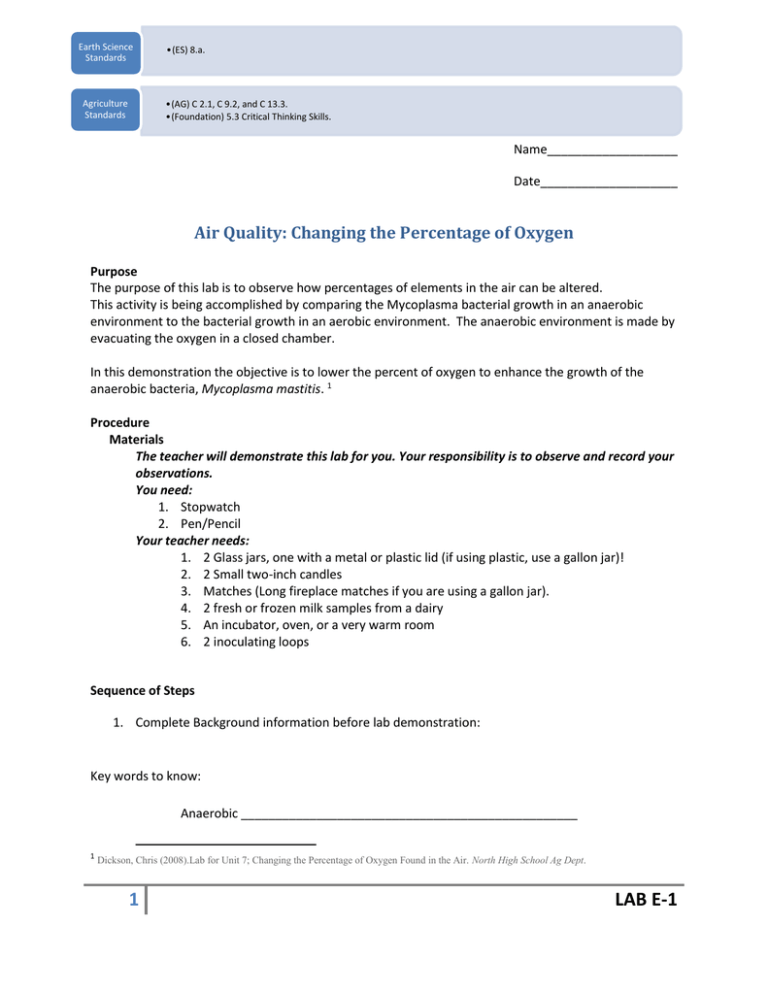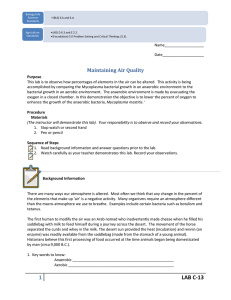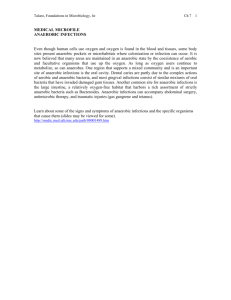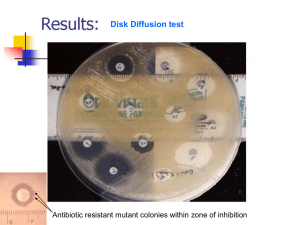E-1 Air Quality
advertisement

Earth Science Standards Agriculture Standards •(ES) 8.a. •(AG) C 2.1, C 9.2, and C 13.3. •(Foundation) 5.3 Critical Thinking Skills. Name___________________ Date____________________ Air Quality: Changing the Percentage of Oxygen Purpose The purpose of this lab is to observe how percentages of elements in the air can be altered. This activity is being accomplished by comparing the Mycoplasma bacterial growth in an anaerobic environment to the bacterial growth in an aerobic environment. The anaerobic environment is made by evacuating the oxygen in a closed chamber. In this demonstration the objective is to lower the percent of oxygen to enhance the growth of the anaerobic bacteria, Mycoplasma mastitis. 1 Procedure Materials The teacher will demonstrate this lab for you. Your responsibility is to observe and record your observations. You need: 1. Stopwatch 2. Pen/Pencil Your teacher needs: 1. 2 Glass jars, one with a metal or plastic lid (if using plastic, use a gallon jar)! 2. 2 Small two-inch candles 3. Matches (Long fireplace matches if you are using a gallon jar). 4. 2 fresh or frozen milk samples from a dairy 5. An incubator, oven, or a very warm room 6. 2 inoculating loops Sequence of Steps 1. Complete Background information before lab demonstration: Key words to know: Anaerobic _________________________________________________ 1 Dickson, Chris (2008).Lab for Unit 7; Changing the Percentage of Oxygen Found in the Air. North High School Ag Dept. 1 LAB E-1 Aerobic ___________________________________________________ Key information to know: Percent nitrogen in the air _________% Percent oxygen in the air _________% Examples of two bacteria that live in anaerobic environments: a. __________________________ b. __________________________ Examples of food processed in anaerobic environments: a. __________________________ b. __________________________ What is Mycoplasma mastitis? _____________________________________________________ ______________________________________________________________________________ _______________________________________________________________________ 2. Observe lab demonstrated by your teacher. Record your observations below. Observations 1. What size jar was used in this demonstration? ________________________ 2. How many seconds did it take for the flame to use the oxygen in the sealed chamber? __________ seconds 3. How many colonies of Mycoplasma could be observed before incubation? a. In the sealed chamber (anaerobic environment) ______________ b. In the open chamber aerobic environment) _______________ 4. How many colonies of Mycoplasma could be observed 24-hours after incubation? 2 LAB E-1 a. In the sealed chamber (anaerobic environment) ______________ b. In the open chamber aerobic environment) _______________ 5. 5. How many colonies of Mycoplasma could be observed 48-hours after incubation? a. In the sealed chamber (anaerobic environment) ______________ b. In the open chamber aerobic environment) _______________ 6. Did the data support the objective that more colonies would grow in the anaerobic environment? ___________ 7. If the data rejected the objective that more colonies would grow in the anaerobic environment, what might be the reason? ____________________ _____________________________________________________________ _____________________________________________________________. 3 LAB E-1 Teacher’s Lab Guide: Changing the Percentage of Oxygen Found in Air SPECIAL SAFETY INSTRUCTIONS Latex gloves are required to set up the following demonstration. Check with your administration as to their procedures for discarding the milk samples after the completion of the demonstration. TIME REQUIRED FOR THIS DEMONSTRATION: The set up time will take about 5 minutes to streak the plates (Petri dishes). If you are using frozen milk samples, allow time for them to thaw prior to streaking. Class time for the demonstration will take about 5 minutes. The student background questions can take up to 30 minutes prior to actually showing how oxygen is removed from the air. 2nd and 3rd day observations will take about 10 minutes. BACKGROUND INFORMATION: There are many ways our atmosphere is altered. Most often we think that any change in the percent of the elements that make up ‘air’ is a negative activity. Many organisms require an atmosphere different than the macro-atmosphere we use to breathe. Examples include certain bacteria such as botulism and tetanus. The first human to modify the air was an Arab nomad who inadvertently made cheese when he filled his saddlebag with milk to feed himself during a journey across the desert. The movement of the horse separated the curds and whey in the milk. The desert sun provided the heat (incubation) and rennin (an enzyme) was readily available from the saddlebag (made from the stomach of a young animal). Historians believe this first processing of food occurred at the time animals began being domesticated by man (circa 9,000 B.C.). PURPOSE OF THE DEMONSTRATION: This lab is to demonstrate (in a relatively short time period – three 10-minute days) the altering of the percentage of oxygen in the air. In this demonstration the objective is to lower the percent of oxygen to enhance the growth of anaerobic bacteria, Mycoplasma mastitis. 4 LAB E-1 MATERIALS NEEDED: 2 Glass jars, one with a metal or plastic lid (if using plastic, use a gallon jar)! 2 Small two-inch candles Matches (Long fireplace matches if you are using a gallon jar). 2 fresh or frozen milk samples from a dairy (a food-animal veterinary with whom you have a rapport, can give you a milk samples; Petri dishes and Mycoplasma spp media. (Mycoplasma spp. will not grow on blood agar incubated aerobically). An incubator, oven, or a very warm room 2 inoculating loops PROCEDURE Streak the Petri dishes (plates) using inoculating loops just prior to the beginning of class. (Students will be focused on streaking techniques instead of evacuating oxygen if you streak the plates as part of the class demonstration). To attain an oxygen-free (or almost oxygen-free) environment, place one of the streaked Petri dishes in one of the glass gallon jars, the second dish in the other jar. Place a 2 inch candle in one of the jars. Light the candle and seal the jar with the plastic or metal lid. Students should observe the lighted candle extinguish itself once the oxygen in the air in the environment of the sealed jar is used. (The question may be asked, ‘what takes the place of the 21% of the air that was just burned?’ Suggested answer: An actual vacuum was formed, although very small because of the size of the container. The second jar is not sealed. Place the two jars in an incubator at 90oF for 24-48 hours (or oven, or wrap the jar in a blanket and put in a box and leave it in the sun). The colonies of Mycoplasma spp. will have a fried-egg appearance. Predicted outcome – The sample from the somewhat anaerobic environment should have many more and possible larger colonies than the sample from the aerobic environment. STUDENT HANDOUT Key words to know: Anaerobic: in the absence of oxygen Aerobic : in the presence of oxygen Background information: Percent nitrogen in the air: 21% Percent oxygen in the air: 78% 5 LAB E-1 Examples of two bacteria that live in anaerobic environments: c. Clostridium tetani (tetanus) d. Clostridium botulinum (botulism) Examples of food processed in anaerobic environments: a. cheese b. sauerkraut What is Mycoplasma mastitis? Mycoplasma bovis is the most common bacteria causing mastitis-like signs. It is highly contagious, and apparently harbors in the respiratory tract of the bovine. Purpose – This lab is to observe how percentages of elements in the air can be altered. This activity is being accomplished by comparing the Mycoplasma bacterial growth in an anaerobic environment to the bacterial growth in an aerobic environment. The anaerobic environment is made by evacuating the oxygen in a closed chamber with the use of a candle. In this demonstration the objective is to lower the percent of oxygen to enhance the growth of the aerobic bacteria, Mycoplasma mastitis. Materials Needed (The instructor will demonstrate this lab). Your responsibility is to observe and record your observations. Stop watch or second hand Pen or pencil Observations 1. What size jar was used in this demonstration? gallon – quart - pint 2. How many seconds did it take for the flame to use the oxygen in the sealed chamber? varies seconds 3. How many colonies of Mycoplasma could be observed before incubation? a. In the sealed chamber (anaerobic environment) 0 b. In the open chamber aerobic environment) 0 4. How many colonies of Mycoplasma could be observed 24-hours after 6 LAB E-1 incubation? a. In the sealed chamber (anaerobic environment) ______________ b. In the open chamber aerobic environment) _______________ 5. 5. How many colonies of Mycoplasma could be observed 48-hours after incubation? a. In the sealed chamber (anaerobic environment) ______________ b. In the open chamber (aerobic environment) _______________ 6. Did the data support the objective that more colonies would grow in the anaerobic environment? ___________ 7. If the data rejected the objective that more colonies would grow in the anaerobic environment, what might be the reason? Could be that the jar was not sealed tightly enough, could be that we are seeing colonies of aerobic bacteria (some other bacteria growing). 7 LAB E-1




